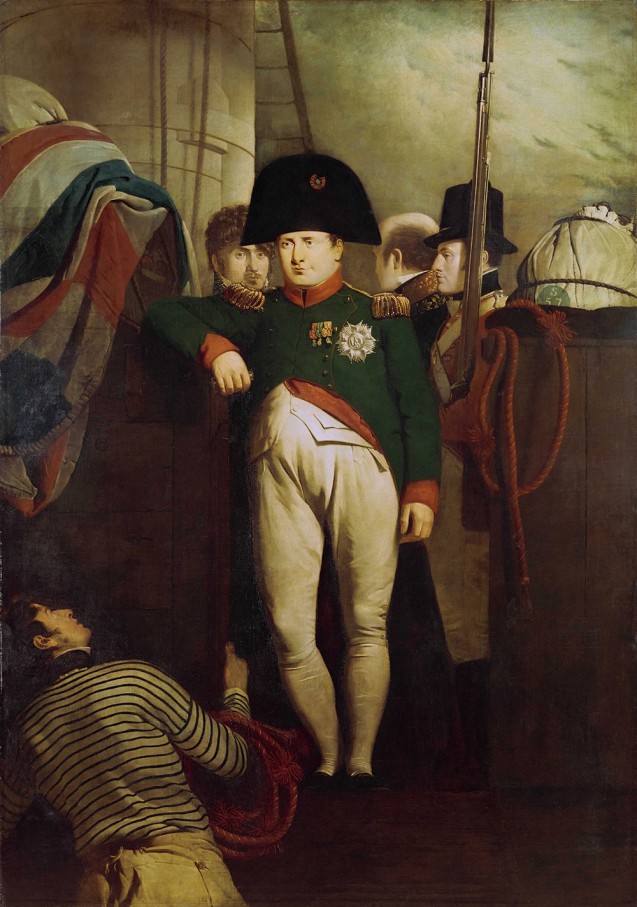In this full-length portrait of Napoleon, Charles Lock Eastlake represents the deposed Emperor, dressed in the green uniform of a colonel of the “chasseurs à cheval de la Garde”, on the bridge of Bellerophon which he had boarded on 15 July 1815, ultimately putting his fate in the hands of the British Prince Regent, after a failed attempt to reach the United States.
Several characters surround the Emperor. Behind him can be seen two heads: on the left, seen from the front, that of Captain Piontkowski in the uniform of the Polish Guard, looking out at the viewer; on the right, seen from the back, that of General Bertrand (the closest among those faithful to Napoleon, who had followed the Emperor to Elba) the least visible of all the characters, almost anonymous. Two other characters are present, creating a diagonal (on two different levels) that crosses right through the centre of the picture and therefore the Emperor. Napoleon is flanked to his left and to his right, but also before and behind him, by two British sailors. The one on the right stands in a guard position, his gun pointed at the sky, the face bearing no real expression, while the second, manoeuvring probably a rope mat, is staring at the deposed Emperor from a low angle, as if in reverence. These two figures summarise the ambivalent feelings of the sailors towards the one who, in their imagination, had been the worst enemy of their country for over ten years.
Undoubtedly, the posture and expression of the Emperor are fascinating. With a relatively casual attitude, his right elbow resting on one of the ship’s parapets, and his gaze somewhat absent, he seems to ignore the viewer as well as his immediate environment, including the crumpled-up Union Jack, the symbol of his defeat, which dominates the scene to his right. The general impression is at odds with the romantic or tragic vision of dejection with which the painter could have chosen to infuse his work. One almost wonders if Napoleon’s empty look is not the effect of the seasickness from which Napoleon is known to have suffered throughout his Channel crossing to Torbay.
On 26 July, the British government decided that Bellerophon be moved from Torbay towards Plymouth Bay, to prevent the Emperor from setting foot on British soil. However for days, curious sightseers in a multitude of little boats hovered around Bellerophon waiting excitedly for a possible glimpse of the “ogre”, as represented later by Jules Girardet in a painting now preserved in Plymouth. The painter of the work here, Charles Lock Eastlake, himself rented a boat in order to be able to make sketches of Napoleon. The former French sovereign seemed to enjoy the attention and would greet the British subjects who had come to see him. In this scene, however we are far from such a parade: perhaps he already sees that his exile is not going to be as easy as he had hoped; his expression is difficult to determine, his gaze, distant: the Legend is about to take wings.
Soon rumours of an exile to St Helena began to appear in the press. Indeed Napoleon was already on the island in the South Atlantic when, in October 1815, this painting received its first showing, in London at the British Institution. This was to be Eastlake first big success, the work attracting onlookers who had not been able to sail around Bellerophon in July. Yet the artificial position of the French Emperor – Napoleon still considered himself one, despite his abdication, and he intended to maintain court etiquette on the British ship – suggests that the painter had not only relied on his sketches taken from life but was perhaps inspired by other representations of Napoleon.
During the months before the Battle of Waterloo and the second exile, Eastlake had visited Paris including the “Musée Napoléon”, (now known as “The Louvre”). It is therefore not impossible that he also visited the Paris studio of the painter David, who only settled in exile in Brussels after the second abdication. The official court painter then had in his studio a second version of the famous “Napoléon dans son cabinet de travail” which (unlike the original that represents Napoleon in the uniform of colonel of the grenadiers de la Garde impériale) depicts him in a very similar posture and in the same uniform as the portrait of Eastlake.
The painter, who would go on to translate Goethe’s works on aesthetics, became in 1843 the first curator (1843) and then first director (1855) of the National Gallery in London and president of the Royal Academy in 1850. A humanist and open to European culture, he also bequeathed a large collection to the National Gallery upon his death in 1865.
Marie de Bruchard, June 2015
trans. Rebecca Young


